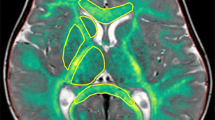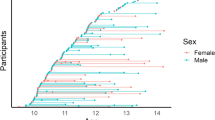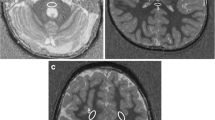Abstract
Purpose
This study aims to provide a screening scoring method by assessing the age-related change of subcortical white matter (WM) myelination via T2-weighted imaging (T2WI).
Methods
This study retrospectively recruited 109 children aged 6–48 months without abnormalities on MRI. Based on Parazzini’s study, we developed a modified T2WI-based method to assess subcortical WM myelination (frontal, temporal, parietal, occipital lobes, and insula) by scoring WM’s signal changes. Inter- and intra-observer agreements were evaluated by Bland-Altman plot. Age-related changes of myelination score were explored by locally weighted scatterplot smoothing (LOESS), linear regression, and Spearman correlation coefficients (r). Relationships between diffusion tensor imaging (DTI) metrics and total myelination score were investigated to further validate practicability of the scoring method by tract-based spatial statistics (TBSS).
Results
This method showed good intra-observer (mean difference = 0.18, SD = 0.95) and inter-observer agreements (mean difference = − 0.06, SD = 1.01). The LOESS and linear regression results indicated that myelination proceeded in two phases: a period of rapid growth (6–20 months; slope = 0.561) and one of slower growth (21–48 months; slope = 0.097). Significant correlations between myelination score and age were observed in whole subcortical WM (r = 0.945; P < 0.001) and all regional subcortical WM (r_mean = 0.819, range, 0.664–0.928; P < 0.001). TBSS found significant correlations of WM-DTI metrics with myelination score during the range of 6–20 months, while no significant correlation was observed in 21–48 months.
Conclusion
The modified T2WI-based screening scoring method is easily feasible to assess myelination progression of subcortical WM, especially suitable for children aged 6–20 months. It may show potential in identifying individual developmental abnormalities by scoring assessment in the future clinical practice.





Similar content being viewed by others
Abbreviations
- AD:
-
Axial diffusivity
- DTI:
-
Diffusion tensor imaging
- FA:
-
Fractional anisotropy
- FMRIB:
-
Functional MRI of the brain
- FSL:
-
FMRIB software library
- FSE:
-
Fast spin echo
- FLAIR:
-
Fluid-attenuated inversion recovery
- FOV:
-
Field of view
- LOESS:
-
Locally weighted scatterplot smoothing model
- RD:
-
Radial diffusivity
- SWI:
-
Susceptibility weighted imaging
- TBSS:
-
Tract-based spatial statistics
- T2WI:
-
T2-weighted imaging
- T1WI:
-
T1-weighted imaging
- WM:
-
White matter
References
Barkovich AJ (2005) Magnetic resonance techniques in the assessment of myelin and myelination. J Inherit Metab Dis 28(3):311–343. https://doi.org/10.1007/s10545-005-5952-z
Barkovich AJ, Kjos BO, Jackson DE Jr, Norman D (1988) Normal maturation of the neonatal and infant brain: MR imaging at 1.5 T. Radiology 166(1 Pt 1):173–180. https://doi.org/10.1148/radiology.166.1.3336675
Barkovich AJ (2000) Concepts of myelin and myelination in neuroradiology. AJNR Am J Neuroradiol 21(6):1099–1109
Huppi PS, Dubois J (2006) Diffusion tensor imaging of brain development. Semin Fetal Neonatal Med 11(6):489–497. https://doi.org/10.1016/j.siny.2006.07.006
Callaghan MF, Freund P, Draganski B, Anderson E, Cappelletti M, Chowdhury R, Diedrichsen J, Fitzgerald TH, Smittenaar P, Helms G, Lutti A, Weiskopf N (2014) Widespread age-related differences in the human brain microstructure revealed by quantitative magnetic resonance imaging. Neurobiol Aging 35(8):1862–1872. https://doi.org/10.1016/j.neurobiolaging.2014.02.008
Song S-K, Sun S-W, Ramsbottom MJ, Chang C, Russell J, Cross AH (2002) Dysmyelination revealed through MRI as increased radial (but unchanged axial) diffusion of water. NeuroImage 17(3):1429–1436. https://doi.org/10.1006/nimg.2002.1267
Gao W, Lin W, Chen Y, Gerig G, Smith JK, Jewells V, Gilmore JH (2009) Temporal and spatial development of axonal maturation and myelination of white matter in the developing brain. AJNR Am J Neuroradiol 30(2):290–296. https://doi.org/10.3174/ajnr.A1363
Parazzini C, Baldoli C, Scotti G, Triulzi F (2002) Terminal zones of myelination: MR evaluation of children aged 20-40 months. AJNR Am J Neuroradiol 23(10):1669–1673
N B (1993) Bayley scales of infant development, 2nd edn. Psychological Corporation, San Antonio
Augustyniak M, Mrozek-Budzyn D, Kieltyka A, Majewska R (2013) Stability of the mental and motor Bayley Scales of Infant Development (2nd ed.) in infants over first three years of life. Przegl Epidemiol 67 (3):483–486, 581-484
Vade A, Sukhani R, Dolenga M, Habisohn-Schuck C (1995) Chloral hydrate sedation of children undergoing CT and MR imaging: safety as judged by American Academy of Pediatrics guidelines. AJR Am J Roentgenol 165(4):905–909. https://doi.org/10.2214/ajr.165.4.7676990
Bracken J, Heaslip I, Ryan S (2012) Chloral hydrate sedation in radiology: retrospective audit of reduced dose. Pediatr Radiol 42(3):349–354. https://doi.org/10.1007/s00247-011-2279-9
Zarifi MK, Evlogias N, Vritsiou M, Theodoropoulos V (1995) Medium dose chloral hydrate for sedation of infants and children undergoing CT. Eur Radiol 5:524–527
Kauffman RBW, Berlin C et al (1993) American Academy of Pediatrics Committee on Drugs and Committee on Environmental Health: use of chloral hydrate for sedation in children. Pediatrics 92(3):471–473
Ball G, Counsell SJ, Anjari M, Merchant N, Arichi T, Doria V, Rutherford MA, Edwards AD, Rueckert D, Boardman JP (2010) An optimised tract-based spatial statistics protocol for neonates: applications to prematurity and chronic lung disease. NeuroImage 53(1):94–102. https://doi.org/10.1016/j.neuroimage.2010.05.055
Li X, Gao J, Wang M, Wan M, Yang J (2016) Rapid and reliable tract-based spatial statistics pipeline for diffusion tensor imaging in the neonatal brain: applications to the white matter development and lesions. Magn Reson Imaging 34(9):1314–1321. https://doi.org/10.1016/j.mri.2016.07.011
Li X, Gao J, Wang M, Zheng J, Li Y, Hui ES, Wan M, Yang J (2017) Characterization of extensive microstructural variations associated with punctate white matter lesions in preterm neonates. AJNR Am J Neuroradiol 38(6):1228–1234. https://doi.org/10.3174/ajnr.A5226
Welker KM, Patton A (2012) Assessment of normal myelination with magnetic resonance imaging. Semin Neurol 32(1):15–28. https://doi.org/10.1055/s-0032-1306382
Dietrich RB, Bradley WG, Zaragoza EJ, Otto RJ, Taira RK, Wilson GH, Kangarloo H (1988) MR evaluation of early myelination patterns in normal and developmentally delayed infants. AJR Am J Roentgenol 150(4):889–896. https://doi.org/10.2214/ajr.150.4.889
Maricich SM, Azizi P, Jones JY, Morriss MC, Hunter JV, Smith EO, Miller G (2007) Myelination as assessed by conventional MR imaging is normal in young children with idiopathic developmental delay. AJNR Am J Neuroradiol 28(8):1602–1605. https://doi.org/10.3174/ajnr.A0602
Dubois J, Dehaene-Lambertz G, Kulikova S, Poupon C, Huppi PS, Hertz-Pannier L (2014) The early development of brain white matter: a review of imaging studies in fetuses, newborns and infants. Neuroscience 276:48–71. https://doi.org/10.1016/j.neuroscience.2013.12.044
Dennis EL, Jahanshad N, McMahon KL, de Zubicaray GI, Martin NG, Hickie IB, Toga AW, Wright MJ, Thompson PM (2014) Development of insula connectivity between ages 12 and 30 revealed by high angular resolution diffusion imaging. Hum Brain Mapp 35(4):1790–1800. https://doi.org/10.1002/hbm.22292
Barkovich AJMP (2011) Normal development of the neonatal and infant brain, skull, and spine. Pediatric Neuroimaging:20–80
Geng X, Gouttard S, Sharma A, Gu H, Styner M, Lin W, Gerig G, Gilmore JH (2012) Quantitative tract-based white matter development from birth to age 2years. NeuroImage 61(3):542–557. https://doi.org/10.1016/j.neuroimage.2012.03.057
Hermoye L, Saint-Martin C, Cosnard G, Lee S-K, Kim J, Nassogne M-C, Menten R, Clapuyt P, Donohue PK, Hua K, Wakana S, Jiang H, van Zijl PCM, Mori S (2006) Pediatric diffusion tensor imaging: normal database and observation of the white matter maturation in early childhood. NeuroImage 29(2):493–504. https://doi.org/10.1016/j.neuroimage.2005.08.017
Nelson CA 3rd, Zeanah CH, Fox NA, Marshall PJ, Smyke AT, Guthrie D (2007) Cognitive recovery in socially deprived young children: the Bucharest Early Intervention Project. Science (New York, NY) 318(5858):1937–1940. https://doi.org/10.1126/science.1143921
Carmody DP, Dunn SM, Boddie-Willis AS, Kevin DeMarco J, Michael L (2004) A quantitative measure of myelination development in infants, using MR images. Neuroradiology 46(9):781–786
Oishi K, Zilles K, Amunts K, Faria A, Jiang H, Li X, Akhter K, Hua K, Woods R, Toga AW, Pike GB, Rosa-Neto P, Evans A, Zhang J, Huang H, Miller MI, van Zijl PCM, Mazziotta J, Mori S (2008) Human brain white matter atlas: identification and assignment of common anatomical structures in superficial white matter. NeuroImage 43(3):447–457. https://doi.org/10.1016/j.neuroimage.2008.07.009
Parent ACM (1996) Carpenter’s human neuroanatomy, 9th edn. Williams & Wilkins, Baltimore
Ball G, Srinivasan L, Aljabar P, Counsell SJ, Durighel G, Hajnal JV, Rutherford MA, Edwards AD (2013) Development of cortical microstructure in the preterm human brain. Proc Natl Acad Sci U S A 110(23):9541–9546. https://doi.org/10.1073/pnas.1301652110
Author information
Authors and Affiliations
Corresponding author
Ethics declarations
Funding
This study was funded by the National Key Research and Development Program of China (2016YFC0100300), the National Natural Science Foundation of China (Nos. 81171317, 81471631, 81771810 and 51706178), the 2011 New Century Excellent Talent Support Plan of the Ministry of Education, China (NCET-11-0438), the China Postdoctoral Science Foundation (No. 2017M613145), the Shaanxi Provincial Natural Science Foundation for Youths of China (No. 2017JQ8005) and the Clinical Research Award of the First Affiliated Hospital of Xi’an Jiaotong University (No. XJTU1AF-CRF-2015-004).
Conflict of interest
The authors declare that they have no conflict of interest.
Ethical approval
All procedures performed in studies involving human participants were in accordance with the ethical standards of the institutional and/or national research committee and with the 1964 Helsinki declaration and its later amendments or comparable ethical standards.
Informed consent
Informed consent was obtained from all individual participants included in the study.
Electronic supplementary material
Supplementary Fig. 1
Spearman correlation coefficient of the myelination score of peritrigonal region and age. (PNG 147 kb)
Supplementary Fig. 2
Spearman correlations of white matter DTI metrics with age of 6–20 months. Green color indicates the fibrous skeleton of brain white matter and represents no significant correlation. The red-yellow color scale indicates the positively correlated regions and blue- light blue color scale indicates the negatively correlated regions. (PNG 1766 kb)
Supplementary Fig. 3
Spearman correlations of white matter DTI metrics with age of 21–48 months. Green color indicates the fibrous skeleton of brain white matter and represents no significant correlation. The blue- light blue color scale indicates the negatively correlated regions. (PNG 1142 kb)
ESM 1
(DOCX 38 kb)
Rights and permissions
About this article
Cite this article
Liu, C., Jin, C., Jian, Z. et al. Assessment of myelination progression in subcortical white matter of children aged 6–48 months using T2-weighted imaging. Neuroradiology 60, 1343–1351 (2018). https://doi.org/10.1007/s00234-018-2108-z
Received:
Accepted:
Published:
Issue Date:
DOI: https://doi.org/10.1007/s00234-018-2108-z




